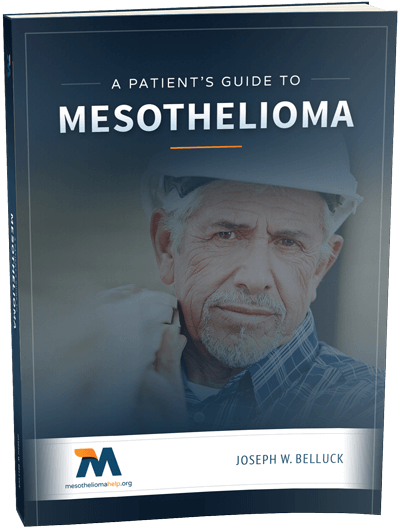Mesothelioma Help Cancer News

How Does Mesothelioma Affect Your Body?
Mesothelioma can cause fluid buildup in your heart, lungs, and abdomen; pain in your chest, stomach, and back; and flu-like symptoms. It can also bring on weight loss and fatigue. Although mesothelioma is a challenging disease to manage, knowing how it will impact your body may better help prepare you for the road ahead.
Head and Brain
- Mesothelioma can affect a patient’s mental stability leading to depression, anxiety, and sadness.
- Confusion, forgetfulness, and brain fog are common complaints for mesothelioma patients on chemotherapy. This is sometimes referred to as “chemo brain.”
- Patients may experience general malaise from mesothelioma, including flu-like symptoms such as chills, fever, night sweats, headache, runny nose, congestion, sore throat, and cough.
- Pericardial mesothelioma patients can feel lightheaded or dizzy.
Lungs
- Pleural mesothelioma is the most common form of the asbestos cancer, found in the outer lining of the lungs and primarily causing respiratory issues.
- Fluid builds up between the lungs and chest, known as pleural effusion, impeding the patient’s breathing by limiting the expansion of the lung. This results in chest pain and a shortage of oxygen that leads to shortness of breath and fatigue.
- Infection of the airways and lungs, often caused by bronchitis and pneumonia, is accompanied by excessive coughing, a tight feeling in the chest, increased rate of breathing, and wheezing. These infections are life-threatening to mesothelioma patients and require immediate medical attention.
- Constant and acute coughing can be painful and exhausting.
Chest
- Mesothelioma tumors present as a large mass that blends in with healthy tissue and may lead to pain under the rib cage and/or unusual lumps of tissue under the skin on the chest.
- Over half of pleural mesothelioma patients suffer pain in the lower, back, and sides of the chest caused by pressure from the tumors.
- For surgical patients, the pleurectomy/decortication (P/D) or extrapleural pneumonectomy (EPP) procedures result in significant pain from the incision made on the side of the chest (thorax) to get to the lungs. Pain in the chest area and incision site can last for several weeks or for months after surgery.
Heart
- Pericardial mesothelioma attacks the pericardium, or the tissue sac that contains the heart and the primary blood vessels. Pericardial mesothelioma patients are said to experience the most severe cancer pain.
- Chest pain and fatigue after exertion are common among pericardial mesothelioma patients.
- The heart struggles to fully expand from the inflammation and can be constricted. Heart palpitations, irregular heartbeat, and heart murmurs are all symptoms.
- Fluid can build in the heart, causing the heart to try to work even harder and resulting in overall fatigue.
Back
- Mesothelioma can irritate nerves throughout the chest or the lining of the lungs that can be felt as pain in the back.
- Mesothelioma that has metastasized to bones in the spine can lead to back pain.
Stomach
- Peritoneal mesothelioma affects the lining of the abdomen and can cause significant discomfort in the abdominal area.
- Patients can experience abdominal pain and tenderness as a result of the tumor, swelling, and surgery.
- Nearly all patients suffer from fluid accumulation, which leads to uncomfortable abdominal swelling or distension.
- Lumps of tissue in the abdomen may be noticed.
- Weight loss is often experienced by patients of all types of mesothelioma.
Arms
- Weight loss is common for mesothelioma patients and is often noticed in the arms.
- Neuropathy (see Feet) can also affect a mesothelioma patient’s hands.
Legs
- Mesothelioma patients are especially susceptible to blood clots, or deep vein thrombosis, due to the high doses of chemotherapy, limited mobility from fatigue and breathing difficulties, and the invasive surgeries that require significant time confined to a bed. Deep vein thrombosis occurs when a blood clot forms in one or more of the deep veins in your body and most often is found in the legs.
- Pericardial mesothelioma patients often experience swelling of the legs, ankles, and feet due to fluid retention.
Feet
- Neuropathy, also called peripheral neuropathy, is weakness, numbness, tingling, or burning often felt in the feet and hands caused by nerve damage. Neuropathy often results from chemotherapy treatments for mesothelioma. Neuropathy can impair a patient’s ability to walk, and a cane may be needed for stability.
Testicles
- Tunica Vaginalis (testicular) mesothelioma is the rarest form of asbestos cancer and is found in the tissues surrounding the testes.
- A mass in the testicle, accumulation of fluid in the scrotum and testicular swelling are common symptoms of this cancer.
Psychological Effects of Mesothelioma
Dealing with the physical effects of mesothelioma is hard enough, but managing family and financial issues at the same time can lead to additional harmful health effects from the stress. A stressed patient is less likely to respond to cancer treatments and could experience a further decline in health.
Physicians believe that a positive outlook and affirming thoughts can result in the improvement in a patient’s health. Many mesothelioma patients try to look beyond the disease and focus on what they can control.
Some ways to ease stress include:
- Build a strong emotional connection with your medical team.
- Be an empowered patient by taking on treatment in collaboration with your doctor.
- Find emotional support from loved ones, friends, or through support groups.
- Take on a daily meditation ritual, listen to soothing music, or read poetry or empowering quotes.
- Seek comfort from your pet or a therapy pet.
Get Legal Help in Your Fight Against Mesothelioma
If you or a loved one has been diagnosed with mesothelioma, legal help is available. Contact us today to learn about your legal options for pursuing the compensation you deserve.

Nurse Explains Pain Medications for Mesothelioma Patients
No one wants to be in pain. Pain can be debilitating and it can prevent us from enjoying our lives. Controlling pain often requires a multidisciplinary approach. The approach can include medication, guided imagery, meditation and other therapies.
The definition of pain by the International Association for the Study of Pain is, “An unpleasant sensory and emotional experience associated with actual or potential tissue damage, or described in terms of such damage.” Pain experience is individual and unique to the person experiencing the pain.
This week we saw a mesothelioma patient who was recovering from surgery, but did not want to take any pain medications once he left the hospital. The reasons for pain medications are multi-faceted. They can help reduce the chances of pneumonia, that can be a result of not being able to take a deep enough breath. They can help prevent blood clots that form when patients cannot move around enough to prevent blood clots. Pain medication can help a patient sleep better. Poorly managed pain can lead to complications and a longer rehab.
Why didn’t our patient want to take the pain medication? He wanted to get better, he wanted to walk, he wanted to sleep at night, he wanted to go home. What he didn’t want was to become addicted to pain medication. He had heard that is where some people start on the road to addiction and he was not going down that road. A study published in JAMA in 2016, can help quell those fears. According to the researchers, just “0.4% of patients continue to receive prescriptions for opiates at one year.” Previous studies report only about 3% still taking opioids after three months.
Generalizations do not work when managing pain. Like mesothelioma, every person’s disease is different, everyone’s reaction to pain medication, how it works for them, whether they need more or less, is something that should be individualized between the patient and his doctor. The control of pain and it’s side effects, will make for a better recovery, less complications, and get you back to your life.
It is important to discuss your concerns with your care team. Communication with your team about your pain and whether it is improving , changing, or increasing will help your recovery, and improve your patient experience. One size does not fit all! Discuss with your team your concerns and fears- it will lead to a better experience.

“Spider Web” of Proteins Could Lead to Novel Therapies for Mesothelioma
Researchers spend much of their time trying to find that one biomarker or protein to target to make a difference in the way lung cancer, mesothelioma and other cancers are treated. Proteins can drive many cancers, and finding a way to block cell proteins that fuel mesothelioma can make a difference for many patients. Now, researchers believe they have found a “vast spider web” of interactions between proteins that will lead to a new way to treat cancers.
According to a Feb. 16 press release from Emory University, a team of researchers looked closely at tumor suppressor genes that are known to escape drugs, leading the medical research field to call them “undruggable.” It was when looking at these, that the team determined in a set of 83 lung cancer-related proteins there were more than 260 interactions that were not known previously. Through a series of additional tests, they found that nearly 80 percent of the interactions were reliable.
“Our approach is to place tumor suppressors in the context of a network of cancer-associated proteins and link tumor suppressors to drugs through a known drug target protein,” says senior author Haian Fu, PhD. “In this way, changes in a tumor suppressor may be linked with the response of the target to the connected drug.”
The team illustrated the benefit of the interaction web by pinpointing one undruggable protein, Myc. They were able to connect that protein through two proteins, N3D3 and Brd4, along the web, finding that inhibitors have been developed for the Brd4 protein. This allows them to build a pathway, Brd4-NSD3-Myc, as a potential anti-cancer drug target.
Pleural mesothelioma is a rare, serious cancer affecting the lining of the lungs that occurs in individuals exposed to airborne asbestos fibers. Although pleural mesothelioma is distinguished by a large mass of interlocked tumors that blend in with healthy tissue, lung cancer is characterized by more distinct, individual tumors. Despite the differences, any research leading to new treatment options for lung cancer brings hope to all of the mesothelioma community.
Nearly 3,000 Americans are diagnosed with mesothelioma each year. The same number succumb to the incurable cancer.
The results can be found in the Feb. 16 issue of Nature Communications.

Mesothelioma Patient Steps Outside of His Comfort Zone
We all have our own space, our own routines that we are comfortable with- people, stores, our personal routines – that bring us comfort. Being diagnosed with mesothelioma can jolt you out of your comfort zone.
This week I saw a patient who had stepped way out of his comfort zone. He had been diagnosed with mesothelioma a few months ago and had planned to have his treatment locally. But after he researched mesothelioma and found an advocate who advised him to head to a mesothelioma treatment center, he ended up on a plane in order to increase his survival chances. He had come by himself, to a strange city, without his family, to see if there was another option for him.
What makes some people more willing to get out of their comfort zone than others? While researching this I came across an interesting article: “The Science of Breaking Out of Your Comfort Zone (and Why You Should),” by Alan Henry. In the article, Henry defines comfort zone as “a behavioral space where your activities and behaviors fit a routine and pattern that minimizes stress and risk. It provides a state of mental security. You benefit in obvious ways: regular happiness, low anxiety, and reduced stress.”
Your comfort zone is your comfort zone. It is neither a good thing or a bad thing. When it is necessary to come out of our comfort zone, though, how do you do it? Leaving it can cause increased anxiety and risk. This can be a good thing or a bad thing. Sometimes it is a little of both.
Our patient has done well this past week, navigating the system, having tests, communicating it all to his family back home. Was he nervous coming to the mesothelioma center by himself? Yes, he was, but he did it.
Coming to a strange city knowing that you have mesothelioma, a serious cancer, is an extreme example of stepping out of your comfort zone. Sometimes when we step out of our comfort zone we do things that we are not totally comfortable with, but we surprise ourselves and do things we would not otherwise have considered.
Changing things up can lead to personal growth – and may even improve your life!

Rare Disease Day Brings Mesothelioma into the Spotlight
MesotheliomaHelp will be joining the National Organization for Rare Disorders (NORD), and countless other organizations, in the fight to raise awareness of the more than 7,000 rare diseases on Rare Disease Day tomorrow, Feb. 28. For the ninth year, NORD will focus a spotlight on rare diseases as a global public health concern. Mesothelioma, an asbestos-related cancer, is one of the rare, or “orphan,” diseases or conditions affecting one in ten Americans.
In the United States an orphan disease status is assigned to a disease or disorder if it affects fewer than 200,000 Americans at any given time. In the case of mesothelioma, 3,000 Americans are diagnosed with the disease each year.
This year’s focus is on research. Research brings hope to people living with rare diseases and while there is ongoing research to find new treatments or a cure, many of the diseases still do not have effective treatments. There is no cure for mesothelioma and the cancer is resistant to many of the available treatments.
Rare Disease Day is an annual event observed worldwide on the last day of February dedicated to raising awareness among the general public and decision-makers about rare diseases and the impact on patients’ lives. The day was started in 2008 by EURORDIS-Rare Disease Europe. In 2016, more than 85 countries participated, including France, Canada, Greece, and first time participants Aruba, Tanzania, and Zimbabwe.
Expert Insight
NORD
People with rare diseases struggle to get a proper diagnosis, find information, and get treatment.
The organizers want to educate the public about the inequalities in medical care suffered by people with orphan diseases. According to NORD, patients with orphan diseases are often faced with difficulty in finding medical experts, delay in receiving an accurate diagnosis, and access to few, if any, treatment options. In the U.S., malignant mesothelioma patients often have to travel to large cities where the mesothelioma experts practice in order to receive adequate treatment.
Due to the relative rarity of mesothelioma, and other orphan diseases, managing the disease and trying to find appropriate treatment can be overwhelming to the patients and their families. In fact, according to government statistics, between 85 and 90 percent of orphan diseases are serious or life-threatening, yet only about 200 of them currently have any effective treatments.
Rare Disease Day 2017 activities in the U.S. include state legislature awareness events, a Handprints Across America photo gallery on the national website, and events in communities across the U.S.
For more information about Rare Disease Day activities in the U.S, see www.rarediseaseday.us. For information about global activities, see www.rarediseaseday.org.
Free Mesothelioma Patient & Treatment Guide
We’d like to offer you our in-depth guide, “A Patient’s Guide to Mesothelioma,” absolutely free of charge.
It contains a wealth of information and resources to help you better understand the condition, choose (and afford) appropriate treatment, and exercise your legal right to compensation.
Download Now